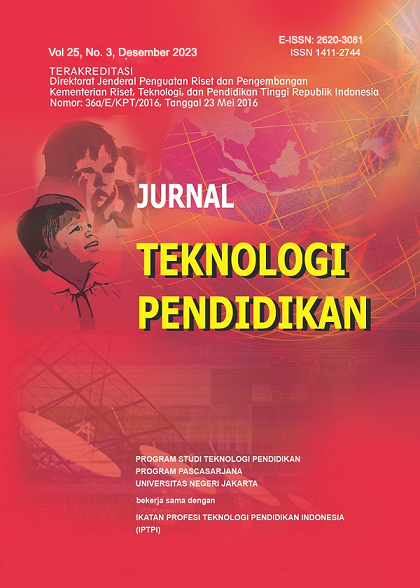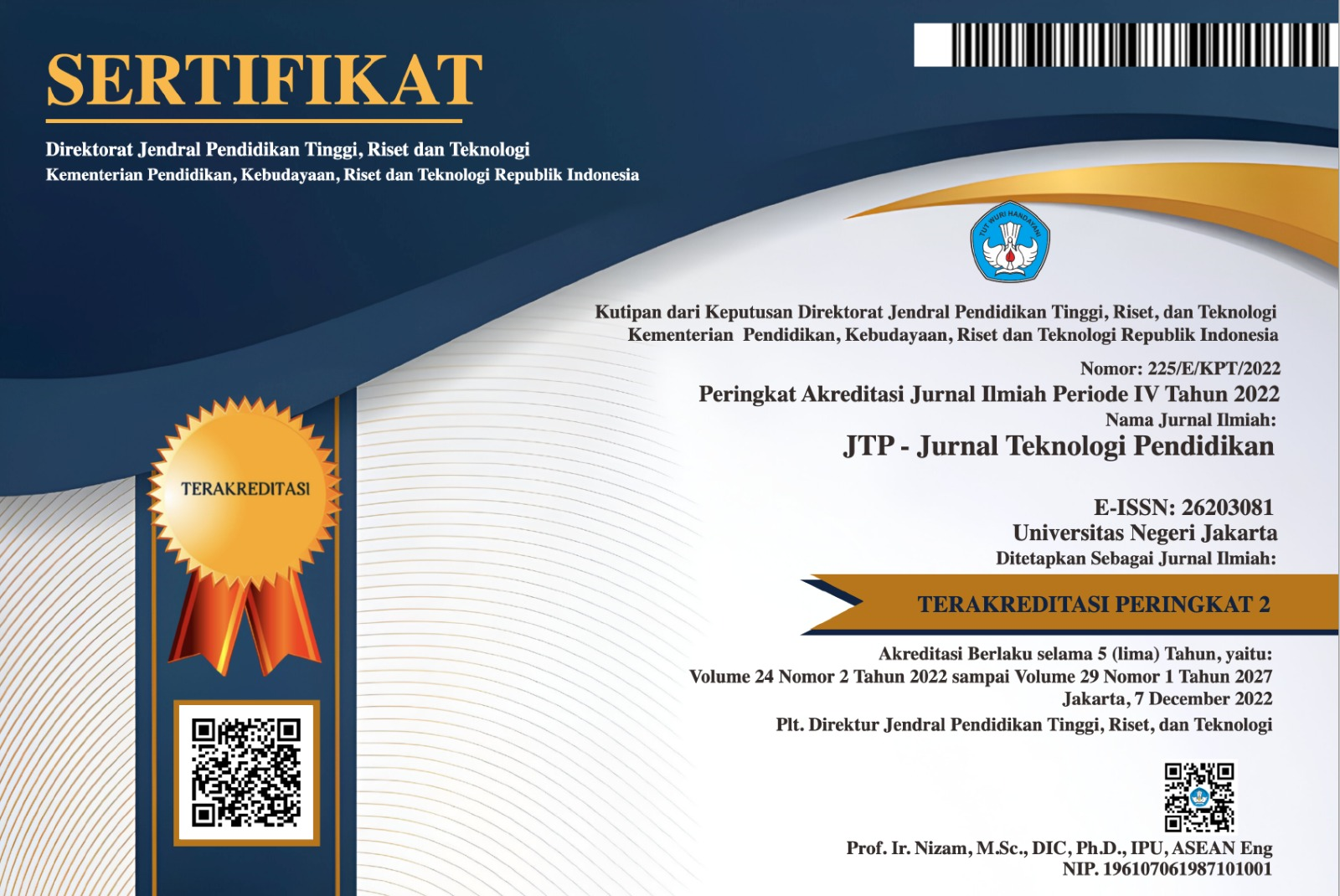Math City Map: Application of Mathematics Outdoor Learning Using Mobile Application
DOI:
https://doi.org/10.21009/jtp.v25i3.40490Keywords:
learning design, outdoor learning, math city map, mobile applicationAbstract
The purpose of this research is to describe the design of outdoor learning using Math City Map (MCM) application. Through several features provided in Math City Map teachers can provide a virtual classroom that serves to support, hone and explore student abilities. This outdoor learning design is the result of the development of learning design in mathematics subjects in elementary and secondary schools. This research uses a qualitative approach, with a descriptive research type. The subjects of this research were teachers and students in Singosari. Data collection techniques using documentation, interviews and observation. The results of the learning design using MCM through four stages, there are 1) determining the learning theme, and outdoor destination or location, 2) briefing all related parties, namely students, teachers and assistants, 3) dividing students into groups, 4) implementing outdoor learning. Implementation of outdoor learning.
References
Armbrüster, Christian, and Matthias D. Witte. 2022. “Outdoor School in Germany. Theoretical Considerations and Empirical Findings.” in High-Quality Outdoor Learning.
Astuti, Arie Puji. 2020. “PENGEMBANGAN MODUL DIGITAL BERBASIS SCL UNTUK MATA KULIAH MATEMATIKA TERAPAN JURUSAN NAUTIKA.” JURNAL PAJAR (Pendidikan Dan Pengajaran) 4(1). doi: 10.33578/pjr.v4i1.7913.
Bartels, Selina L., Kathryn M. Rupe, and Judith S. Lederman. 2019. “Shaping Preservice Teachers’ Understandings of STEM: A Collaborative Math and Science Methods Approach.” Journal of Science Teacher Education 30(6). doi: 10.1080/1046560X.2019.1602803.
Desi Andryani Lubis, Ludi, Iqbal Arianto, Al Ma’ruf, Dan Ashari, and Jeid Amidi. 2021. “Pembelajaran Matematika Budaya (Etnomatematika) Berbantuan Aplikasi Math City Map Untuk Meningkatkan Kemampuan Berpikir Kritis Peserta Didik.” Journal of Educational Integration and Development 1(3).
Emre-Akdoğan, Elçin, and Gönül Yazgan-Sağ. 2018. “An Investigation on How Prospective Mathematics Teachers Design a Lesson Plan.” Ondokuz Mayıs Üniversitesi Eğitim Fakültesi Dergisi 37(1).
Hikmah, Al, Anton Prayitno, and Nia Wahyu Damayanti. 2019. “Penerapan Pembelajaran Outdoor Mathematics Dengan Media Manipulatif Untuk Meningkatkan Hasil Belajar.” Jurnal Penelitian & Pengkajian Ilmiah Mahasiswa (JPPIM) 1(1).
Jailani, Heri Retnawati, Ezi Apino, and Agus Santoso. 2020. “High School Students’ Difficulties in Making Mathematical Connections When Solving Problems.” International Journal of Learning, Teaching and Educational Research 19(8). doi: 10.26803/ijlter.19.8.14.
Kelly, Orla, Karen Buckley, Lauren J. Lieberman, and Katrina Arndt. 2022. “Universal Design for Learning - A Framework for Inclusion in Outdoor Learning.” Journal of Outdoor and Environmental Education 25(1). doi: 10.1007/s42322-022-00096-z.
Khan, Wasiq, Abir Hussain, Bilal Muhammad Khan, and Keeley Crockett. 2023. “Outdoor Mobility Aid for People with Visual Impairment: Obstacle Detection and Responsive Framework for the Scene Perception during the Outdoor Mobility of People with Visual Impairment.” Expert Systems with Applications 228. doi: 10.1016/j.eswa.2023.120464.
Markowski, Marianne, Carole Yearley, and Heather Bower. 2022. “Collaborative Learning in Practice (CLiP) in a London Maternity Ward-a Qualitative Pilot Study.” Midwifery 111. doi: 10.1016/j.midw.2022.103360.
Mettis, Kadri, Terje Väljataga, and Õnne Uus. 2023. “Mobile Outdoor Learning Effect on Students’ Conceptual Change and Transformative Experience.” Technology, Knowledge and Learning 28(2). doi: 10.1007/s10758-022-09614-w.
Muñoz-Carril, Pablo César, Nuria Hernández-Sellés, Eduardo José Fuentes-Abeledo, and Mercedes González-Sanmamed. 2021. “Factors Influencing Students’ Perceived Impact of Learning and Satisfaction in Computer Supported Collaborative Learning.” Computers and Education 174. doi: 10.1016/j.compedu.2021.104310.
Njiku, Joseph, Védaste Mutarutinya, and Jean François Maniraho. 2021. “Building Mathematics Teachers’ Tpack through Collaborative Lesson Design Activities.” Contemporary Educational Technology 13(2). doi: 10.30935/CEDTECH/9686.
Rosanti, Fani, and Amin Harahap. 2022. “Pengaruh Outdoor LearningMath Dengan Pendekatan Math City Mapterhadap Kemampuan Pemecahan Masalah Pada Kelas XII SMK YAPIM Pinang Awan.” Jurnal Cendekia : Jurnal Pendidikan Matematika 6(2):1387–1402. doi: 10.31004/cendekia.v6i2.1363.
Waite, Sue. 2020. “Where Are We Going? International Views on Purposes, Practices and Barriers in School-Based Outdoor Learning.” Education Sciences 10(11). doi: 10.3390/educsci10110311.
Downloads
Published
How to Cite
Issue
Section
License
Copyright (c) 2023 Tri Candra Wulandari, M. Indra Riamizad Raicucu, Zainal Abidin, Otto Fajarianto

This work is licensed under a Creative Commons Attribution-ShareAlike 4.0 International License.
Jurnal Teknologi Pendidikan is an Open Access Journal. The authors who publish the manuscript in Jurnal Teknologi Pendidikan agree to the following terms.
Attribution-ShareAlike 4.0 International (CC BY-SA 4.0)
-
Attribution — You must give appropriate credit, provide a link to the license, and indicate if changes were made. You may do so in any reasonable manner, but not in any way that suggests the licensor endorses you or your use.
-
ShareAlike — If you remix, transform, or build upon the material, you must distribute your contributions under the same license as the original.
- No additional restrictions — You may not apply legal terms or technological measures that legally restrict others from doing anything the license permits.
Notices:
- You do not have to comply with the license for elements of the material in the public domain or where your use is permitted by an applicable exception or limitation.
- No warranties are given. The license may not give you all of the permissions necessary for your intended use. For example, other rights such as publicity, privacy, or moral rights may limit how you use the material.








